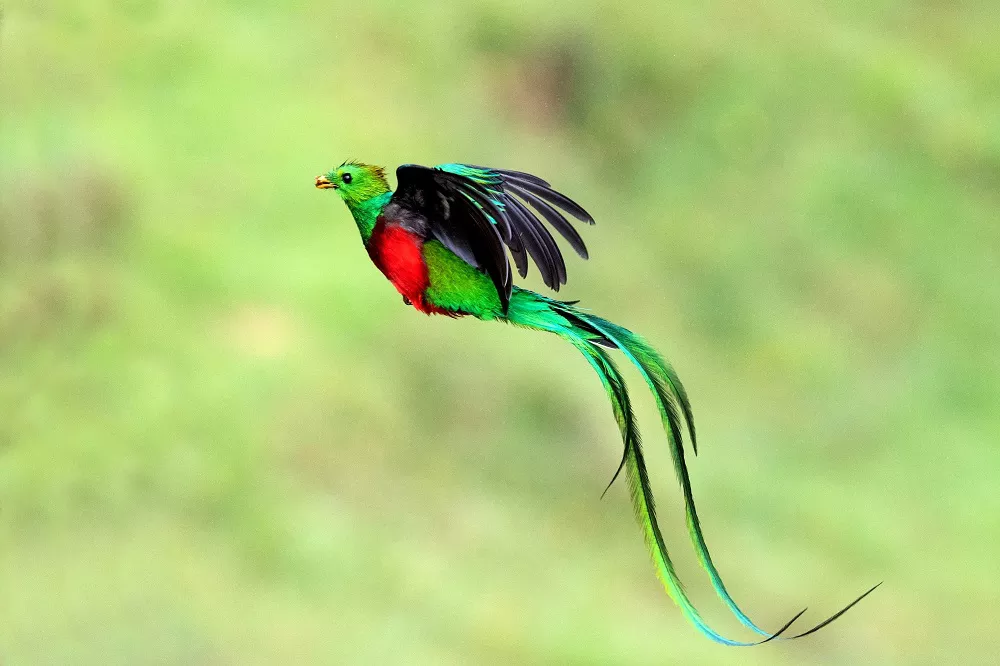The Resplendent Quetzal is a stunningly beautiful bird that inhabits the cloud forests of Central America. This magnificent bird is known for its impressive green and red plumage, as well as its long tail feathers that can reach up to three feet in length. In this article, we’ll take a closer look at the Resplendent Quetzal, exploring its physical characteristics, unique ecological niche, and conservation status.
Physical Characteristics: The Resplendent Quetzal’s Striking Appearance
The Resplendent Quetzal is a relatively large bird, measuring approximately 36-40 cm (14-16 inches) in length. It has a green body and chest, with vibrant red underparts and a blue-green head. The male Resplendent Quetzal has a bright red belly and undertail coverts, while the female has a less intense red coloration on these areas.
What sets the Resplendent Quetzal apart from other birds is its incredibly long and striking tail feathers. These tail feathers are iridescent green and can measure up to three feet in length, making them longer than the bird’s entire body. The male Resplendent Quetzal uses these feathers to attract mates during breeding season, performing elaborate display flights and showing off his impressive plumage.
The Resplendent Quetzal’s wingspan is approximately 60cm (24 inches), and its weight ranges from 150g to 200g (5-7 ounces). Its beak is short and slightly curved, and its eyes are large and dark brown. The Resplendent Quetzal’s legs and feet are small and adapted for perching on branches in the forest canopy.
Unique Ecological Niche: The Resplendent Quetzal’s Role in the Ecosystem
In addition to their striking appearance, Resplendent Quetzals are also known for their unique ecological niche. They are primarily fruit-eating birds, feeding on a variety of fruits, including figs, avocados, and wild cherries. They also eat insects, small lizards, and other small prey when fruit is scarce.
The Resplendent Quetzal plays an important role in the ecosystem of the cloud forest, as it helps to disperse the seeds of many of the fruits it eats. When the bird consumes fruit, it swallows the seeds whole and then excretes them intact, often at a significant distance from the parent tree. This process helps to distribute the seeds throughout the forest, allowing new trees to grow in different areas and increasing the genetic diversity of the forest.
Conservation Status: Threats to the Resplendent Quetzal
Resplendent Quetzals are found in the cloud forests of Central America, including Costa Rica, Panama, Guatemala, and Honduras. They live in high-altitude regions, typically above 1,500 meters (4,900 feet) and prefer to inhabit areas with dense vegetation and tall trees.
Despite their striking beauty, Resplendent Quetzals are threatened by habitat loss and degradation caused by deforestation and agricultural development. Conservation efforts have been implemented in some areas to protect this iconic species, but more work is needed to ensure the survival of this magnificent bird.
One of the major threats to the Resplendent Quetzal is deforestation. As human populations in Central America continue to grow, forests are being cleared to make way for agriculture and urbanization. This has fragmented the bird’s habitat, making it more difficult for them to find suitable nesting sites and food sources.
Other threats to the Resplendent Quetzal include climate change, hunting, and the illegal pet trade. As temperatures rise due to climate change, the bird’s habitat may become unsuitable for its survival. Hunting and the illegal pet trade are also major concerns, as some people consider the bird to be a symbol of wealth and power.
Conclusion: The Importance of Protecting the Resplendent Quetzal
In conclusion, the Resplendent Quetzal is a truly remarkable bird with stunning green and red plumage and long, iridescent tail feathers. This bird’s unique ecological niche and habitat requirements make it an important species for conservation efforts in Central America. By protecting these birds and their habitats, we can help ensure that future generations will be able to enjoy the beauty and wonder of the Resplendent Quetzal for years to come.
Related topics:


 Facebook
Facebook  Instagram
Instagram  Youtube
Youtube 